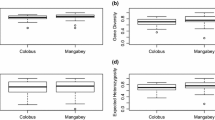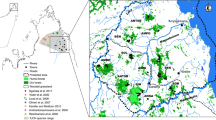Summary
This study focuses on some genetic consequences of habitat fragmentation in populations of four endemic bird species (Monticola sharpei, Terpsiphone mutata, Foudia omissa, andFoudia madagascariensis) living in the understory of forests in the Réserve Spéciale d'Ambohitantely on the Central High Plateau of Madagascar. The four species differ in their dependency on forest habitats, which may be related to their migration abilities between isolated forest fragments. Genetic variation was analysed on the basis of multi-locus fingerprints in order to study the influence of migration and habitat size on the genetic variability of local populations. There was no evidence that forest fragmentation affects any of the four species with respect to genetic variability.
Zusammenfassung
Rund 53 % der Vogelarten Madagaskars sind endemisch. Viele dieser Arten sind an Waldhabitate gebunden und durch die Verinselung der madagassischen Wälder hochgradig bedroht. In dem vorliegenden Projekt wird die Auswirkung der Verinselung auf die genetische Variabilität und die genetische Differenzierung von vier endemischen Vogelarten am Beispiel des Reservats von Ambohitantely im zentralen Hochland Madagaskars untersucht. Ambohitantely beinhaltet mehr als 500 Waldfragmente von 0,64 ha bis 1250 ha. Untersucht wurden: 1. die WaldartFoudia omissa, 2.Monticola (früherPseudocossyphus)sharpei, eine Art mit starker Bevorzugung für primäre Waldlebensräume, die aber gelegentlich auch in Sekundärvegetation auftritt, sowie 3.Terpsiphone mutata und 4.Foudia madagascariensis, beides Arten, die sowohl in Wäldern als auch in offenen Landschaften vorkommen. Die unterschiedliche Abhängigkeit dieser Arten von Waldhabitaten und der damit verbundenen Möglichkeit, offene Landschaften zwischen den Waldfragmenten zu überbrücken, führte zur Frage, ob die Verinselung die genetische Vielfalt der untersuchten Populationen beeinflußt. Für die genetischen Analysen wurden Blutproben von Tieren aus drei Gebieten mit 1250 ha, 136 ha und 28 ha gesammelt. Die Proben wurden mit Multilocus-Fingerprints genetisch charakterisiert. Zum Untersuchungszeitpunkt konnte kein Einfluß der Fragmentierung auf die genetische Populationsstruktur der vier untersuchten Arten nachgewiesen werden.
Similar content being viewed by others
References
Barthlott, W., Lauer, W. & Placke, A. (1996): Global distribution of species diversity in vascular plants: towards a world map of phytodiversity. Erdkunde 50: 317–327.
Bastian, G. (1964): La forêt d'Ambohitantely, Madagascar. Rev. Géographie, Madagascar 5: 1–42.
Brokaw, N. (1998): Fragments past, present and future. Trends Ecol. Evol. 13: 382–383.
Burney, D. A. (1997): Theories and facts regarding Holocene environmental change before and after human colonization. In Goodman, S. M. & Patterson, B. D. (Eds.): Natural change and human impact in Madagascar: 75–89. Washington, D. C.
Cutler, A. (1991): Nested faunas and extinctions in fragmented habitats. Cons. Biol. 5: 496–505.
Gade, D. W. (1996): Deforestation and ist effects in highland Madagascar. Mountain Research and Development 16: 101–116.
Gascon, C. & Lovejoy, T. E. (1998): Ecological impacts of forest fragmentation in central Amazonia. Zoology 101: 273–280.
Green, G. M. & Sussman, R. W. (1990): Deforestation history of the eastern rainforest of Madagascar from satellite images. Science 248: 212–215.
Jenkins, M. D. (1987): Madagascar: an environmental profile. Gland.
Langrand, O. (1990): Guide to the birds of Madagascar. New Haven.
Langrand, O. (1995): The effects of forest fragmentation on bird species in Madagascar: a case study from Ambohitantely Forest Reserve on the Central High Plateau. M. S. Thesis. University of Natal, Pietermaritzburg.
Langrand, O. & Wilmé, L. (1997): Effects of forest fragmentation on extinction patterns of the endemic avifauna on the central high plateau of Madagascar. In Goodman, S. M. & Patterson, B. D. (Eds.): Natural change and human impact in Madagascar: 280–305. Washington, D.C.
Laurance, W. F. & Bierregaard, R. O. (Eds. 1997): Tropical forest remnants. Chicago.
Lowry, P. P., Schatz, G. E. & Phillipson, P. B. (1997): The classification of natural and anthropogenic vegetation in Madagascar. In Goodman, S. M. & Patterson, B. D. (Eds.): Natural change and human impact in Madagascar: 93–123. Washington, D. C.
Lubjuhn, T., Schwaiger, F.-W. & Epplen, J. T. (1994): The analysis of simple repeat loci as applied in evolutionary and behavioral sciences. In Schierwater, B. Streit, B., Wagner, G. P. & DeSalle, R. (Eds): Molecular ecology and evolution: approaches and applications: 33–43. Basel.
Lynch, M. (1990): The similarity index and DNA fingerprinting. Mol. Biol. Evol. 5: 584–599.
Lynch, M. (1991): Analysis of population genetic structure by DNA fingerprinting. In Burke, T., Dolf, G., Jeffreys, A. J. & Wolff, R. (Eds): DNA fingerprinting: approaches and applications: 113–126. Basel.
MacPhee, R. D. E. & Burney, D. A. (1991): Dating of modified femora of extinct dwarfHippopotamus from southern Madagascar: implications for constraining human colonization and vertebrate extinction events. J. Archaeol. Sci. 18: 695–706.
Nei, M. & Li, W. H. (1979): Mathematical models for studying genetic variation in terms of restriction endonucleases. Proc. Natl. Acad. Sci. USA 76: 5269–5273.
Patterson, B. D. (1987). The principle of nested subsets and its implication for biological conservation. Cons. Biol. 1: 323–334.
Ravokatra, M., Wilmé, L. & Goodman, S. M. (1998): Les oiseaux. In: Rakotondravony, D. & Goodman, S. M. (Eds.): Inventaire biologique, Forêt d'Andranomay, Anjozorobe, Recherches pour le Développement, Série Sciences biologiques. No-13: 60–79. Centre d'Information et de Documentation Scientifique et Technique, Antananarivo.
Roff, D. A. & Bentzen, P. (1989): The statistical analysis of mitochondrial DNA polymorphism: chi-square and the problem of small samples. Mol. Biol. Evol. 6: 539–545.
Seutin, G., White, B. N. & Boag, P. T. (1991): Preservation of avian blood and tissue samples for DNA analyses. Can. J. Zool. 69: 82–90.
Southern, E. M. (1975): Detection of specific sequences among DNA fragments separated by gel electrophoresis. J. Mol. Biol. 98: 503–517.
Author information
Authors and Affiliations
Corresponding author
Rights and permissions
About this article
Cite this article
Andrianarimisa, A., Bachmann, L., Ganzhorn, J.U. et al. Effects of forest fragmentation on genetic variation in endemic understory forest birds in central Madagascar. J Ornithol 141, 152–159 (2000). https://doi.org/10.1007/BF01651906
Accepted:
Published:
Issue Date:
DOI: https://doi.org/10.1007/BF01651906




